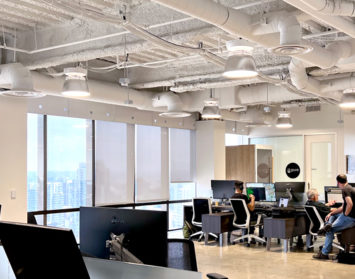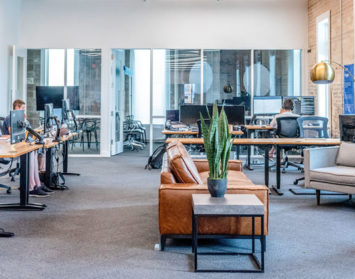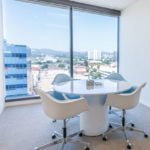By Star Hughes-Gorup
Once brimming with the energy of tech startups, marketing agencies and professional service firms—as well as a thriving retail, dining, arts, theater and music scene—Downtown San Diego has a long way to go to achieve its pre-pandemic vitality. Over the past year and half, many downtown companies moved out of tens of thousands of square feet of office space, leaving more than a 40% availability. That’s nearly five million square feet that’s waiting for tenants to show interest again.
The question is, who is going to move in?
Real estate developers and investors are betting on life science firms to revitalize Downtown San Diego. San Diego is the third-largest life science market in the U.S., and the increasing demand from tech and biotech firms is apparent in the lack of availability in Torrey Pines, UTC and Sorrento Mesa. Simply put, it’s never been this hard for life science firms to secure a spot in their favored region of San Diego. The few spaces that are left are being snapped up at the highest rental rates we’ve seen—a 50,000 square foot facility is leased in a matter of weeks.
As a result, Downtown San Diego’s courtship of life science has begun. There are a handful of major downtown projects underway that promise expansive research and lab space that has never before been available in the downtown market.

Bubbling Up Lab Space
Three projects of note include 1155 Island, The Campus at Horton and the Research and Development District (RaDD).
The project closest to completion is at 1155 Island, an eight-story 203,000 square foot office space that’s being converted to a Premier Class-A life science building. By late 2021, the property will be ready for new tenants who will occupy a sustainable LEED-Gold building that features green design elements, digital connectivity and smart building systems.

The Campus at Horton has a late 2022 completion date and is a major rehaul of San Diego’s five-level downtown mall that spans over six blocks. The campus is designed to meet a zero-carbon goal and will feature cooling by a central on-campus plant, 5 MW photovoltaic and battery storage systems to cut energy costs, and an onsite commercial blackwater treatment system, saving more than half of the campus potable water use. Inside the campus, a 10-story 300,000 square-foot life science tower will provide lab space and can accommodate life science or office tenants.
The third and perhaps most impressive project is IQHQ’s Research and Development District (RaDD), a waterfront property planned for 2023 with the vision to attract biotech or pharmaceutical companies to a prime location spanning three city blocks along the San Diego Bay. The 1.7 million square foot campus will consist of mid-rise structures and a 17-story tower, including rooftop decks and green space. RaDD will offer beautiful views of the bay and access to dining, shopping and music events in nearby Seaport Village, easy access to the USS Midway and stretches of walking and biking paths along the Embarcadero. Its unique design and location will certainly present benefits from a recruiting standpoint.
The future tenants of these new spaces can look forward to a variety of attractive amenities in the downtown market: access to the waterfront, culture and art, Petco Park, Coronado Island, proximity to the airport and hotels, numerous trendy living spaces and nearby eclectic neighborhoods such as South Park and Little Italy. Another plus is starting fall of 2021, the University of California at San Diego—one of the leading life science universities in the nation—will have direct access to downtown via the trolley’s new UC San Diego Blue Line.
But there are various challenges prospective downtown tenants will have to contend with. Rental rates are higher than ever seen before in downtown (in some cases, four times the price of Class A high-rise office space), and parking is an additional cost many life science companies have not had to contend with in the past (a monthly pass typically runs at about $200 to $220 per space per month). Sadly, downtown’s growing homeless population has caused safety and sanitation issues. Another consideration is recruiting efforts—firms may be able to leverage downtown’s metropolitan living to draw in talent, or they may face difficulty if their workforce isn’t keen on commuting from North County San Diego.
Waiting On the First Leap
If one life science user makes the leap to commit to any of these stunning new spaces, it’s very likely others will follow suit. It may be that some life science firms view downtown as a three- to five-year bridge until there’s more space available in the traditional locations (there are more than 40 building conversions taking place right now for delivery of life science infrastructure in the Torrey Pines, UTC, Sorrento and North County submarkets). If life science companies decide to pick up their labs and move to downtown for the long run, it will spark a profound change on the landscape and overall optimism for the future of downtown.
Will San Diego’s downtown become the new frontier for SoCal life science? Only time will tell!
Star Hughes-Gorup is executive vice president and director at Hughes Marino, a global corporate real estate advisory firm that exclusively represents tenants and buyers. Star is a key member of Hughes Marino’s brokerage team, where she specializes in tenant representation and building purchases. Star also makes frequent media appearances to speak on business issues from a millennial perspective, and regularly writes for Hughes Marino’s “Spaces We Love” blog. Contact Star at 1-844-662-6635, or star@hughesmarino.com.











